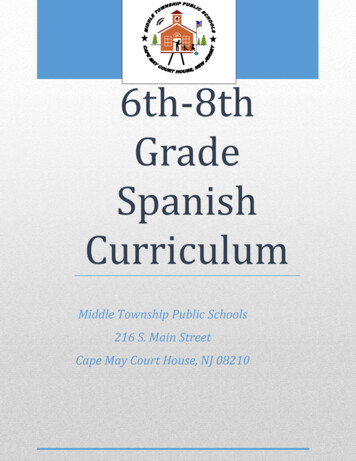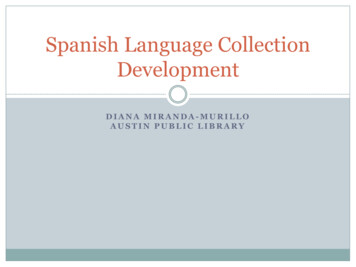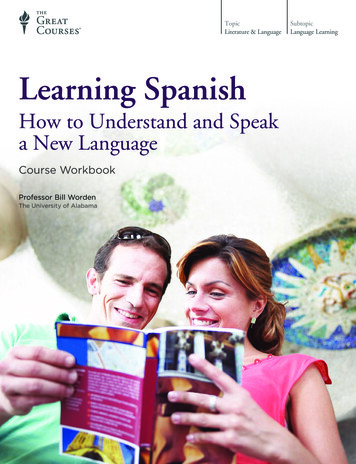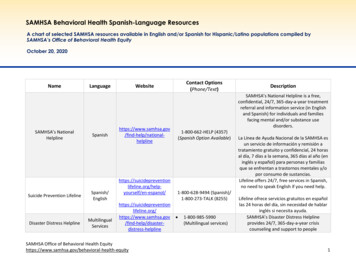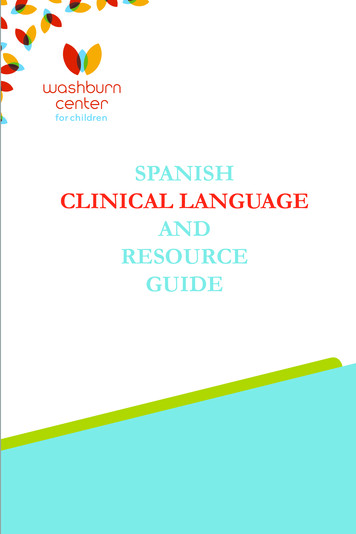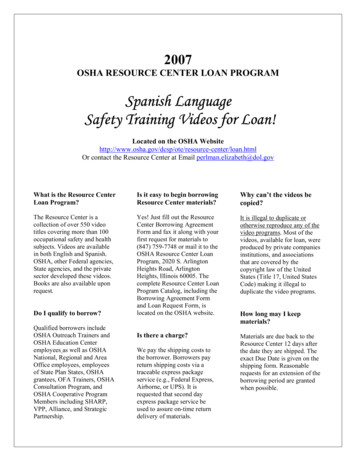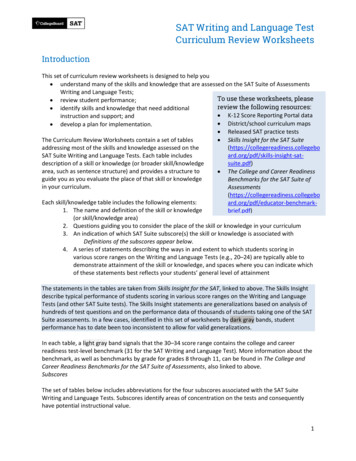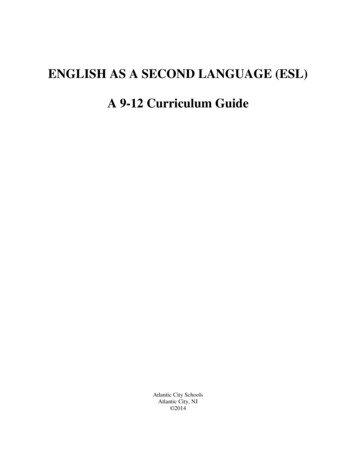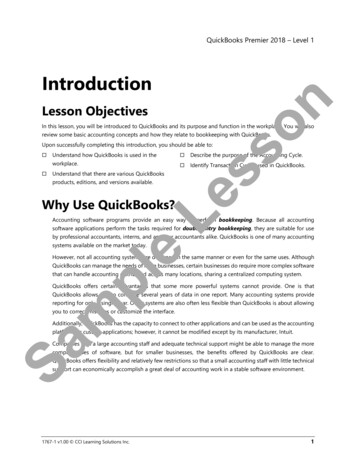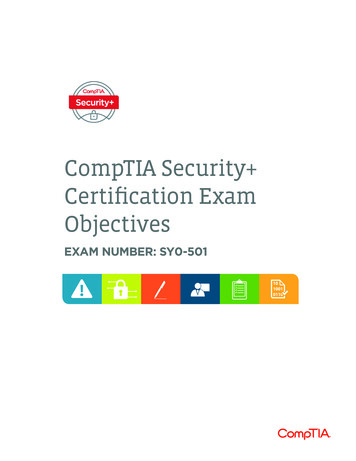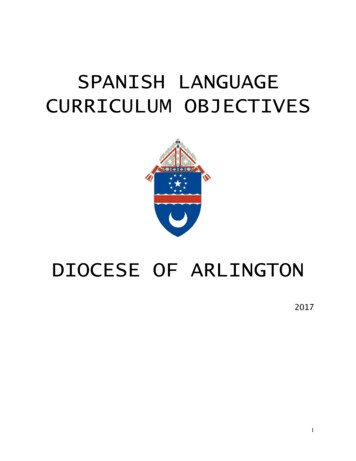
Transcription
SPANISH LANGUAGECURRICULUM OBJECTIVESDIOCESE OF ARLINGTON20171
WORLD LANGUAGES CURRICULUM OBJECTIVESPHILOSOPHYThe teaching of world languages provides a variety of benefits:Teaches listening, speaking, reading, writing and culture with emphasis on communicationExposes students to the beauty and richness of other languages and civilizationsStrengthens cognitive thinking skillsSupports the native language of the student and reinforces English grammarThe ultimate goal of an academic elementary program is to complete successfully the level onehigh school curriculum. The high schools currently require a world language placement testand/or written recommendation by the student’s world language teacher.WORLD LANGUAGE RATIONALETo support the current/existing philosophy incorporated in the Diocesan World LanguageGuidelines, we offer the following rationale:Research indicates the most successful language learning takes place between birth and age tento twelve. At this young age, the child will have an easier time of learning and retaining thelanguage.When children study world language, they develop higher cognitive thinking skills. Foreignlanguage study helps students gain a better understanding of the grammar/ structure of theirnative language. As a result they usually perform better on standardized tests (Terra Nova,HSP/AT, SAT, ACT).Two or three years of world language study in high school do not always provide fluency in aworld language. Fluency will more likely be reached if the child has started world languagelearning much earlier and continues to advanced levels in high school.Study of a world language creates citizens who will learn to accept, understand and appreciatethe diversity of cultures. Thinking globally will help to promote world peace.In our global society, as the world becomes more interdependent, students’ knowledge of worldlanguage is crucial for expanded career opportunities. It will also aid in developing responsiblecitizens of the world community and bring us closer to realizing the Kingdom of God on earth.2
Kindergarten SpanishS. K.1 Introducing oneselfS. K. 2 Basic GreetingsS. K. 3 ColorsS. K. 4 ShapesS. K. 5 Fruit and BeveragesS. K. 6 Numbers 1-20S. K. 7 WeatherS. K. 8 SeasonsS. K. 9 Parts of the bodyS. K. 10 Parts of the FaceS. K. 11 FamilyS. K. 12 AnimalsS. K. 13 Opposite pairs (grande/pequeño, arriba/abajo, adentro/afuera, limpio/sucio)S. K. 14 ClothesS. K. 15 I like/ I do not likeS. K. 16 I want (Yo quiero )S. K. 17 Prayers3
1st Grade SpanishS. 1.1 Introducing oneselfS. 1. 2 Basic GreetingsS. 1. 3 ColorsS. 1. 4 ShapesS. 1. 5 Fruit and BeveragesS. 1. 6 Numbers 1-20S. 1. 7 WeatherS. 1. 8 SeasonsS. 1. 9 Days of the week/months of the yearS. 1. 10 Parts of the bodyS. 1. 11 Parts of the FaceS. 1. 12 FamilyS. 1. 13 AnimalsS. 1. 14 Opposite pairs (grande/pequeño, arriba/abajo, adentro/afuera, limpio/sucio,bueno/malo,alto/bajo)S. 1. 15 ClothesS. 1. 16 I like/ I do not likeS. 1. 17 I want (Yo quiero )S. 1. 18 AlphabetS. 1. 19 HolidaysS. 1. 20 Classroom objectsS. 1. 21 Prayers4
2nd Grade SpanishS. 2.1 Introducing oneselfS. 2. 2 Basic GreetingsS. 2. 3 ColorsS. 2. 4 ShapesS. 2. 5 Fruit and BeveragesS. 2. 6 Numbers 1-50S. 2. 7 WeatherS. 2. 8 SeasonsS. 2. 9 Days of the week/months of the yearS. 2. 10 Parts of the bodyS. 2. 11 Parts of the FaceS. 2. 12 FamilyS. 2. 13 AnimalsS. 2. 14 Opposite pairs (grande/pequeño, arriba/abajo, adentro/afuera, limpio/sucio,bueno/malo, alto/bajo)S. 2. 15 ClothesS. 2. 16 I like/ I do not likeS. 2. 17 I want (Yo quiero )S. 2. 18 HolidaysS. 2. 19 AlphabetS. 2. 20 Classroom objectsS. 2. 21 Prayers5
3rd Grade SpanishS. 3.1 Basic Greetings and Expressions of CourtesyS. 3. 2 ColorsS. 3. 3 Numbers to 100S. 3. 4 Weather/ Days of the Week/ Months of the Year/ SeasonsS. 3. 5 Telling TimeS. 3.6 Parts of the bodyS. 3. 7 Parts of the faceS. 3. 8 FamilyS. 3. 9 AnimalsS. 3. 10 Opposite pairsS. 3. 11 Food VocabularyS. 3. 12 ClothesS. 3. 13 I like/ I don’t likeS. 3. 14 AlphabetS. 3. 15 Capital of Countries in the Caribbean and SpainS. 3. 16 Regions - the Hispanic Caribbean and SpainS. 3.17 I am, You are, He is, She isS. 3. 18 I have, You have, He has, She hasS. 3. 19 Means of TransportationS. 3. 20 ClassroomS. 3. 21 I go to townS. 3. 22 Common words for daily activitiesS. 3. 23 Dialogue with the verb to goS. 3. 24 At the storeS. 3. 25 At the restaurantS. 3. 26 Setting the tableS. 3. 27 Prayers6
4th Grade SpanishFL.4.1Identifying greetings and expressions of courtesyFL.4.2Identifying colorsFL.4.3Identifying body partsFL.4.4Identifying clothingFL.4.5Identifying classroom objectsFL.4.6Writing and counting numbers 1-100 (Latin includes ordinals 1-12)FL.4.7Telling timeFL.4.8Reciting days of week and months of yearFL.4.9Identifying academic subjectsFL.4.10 Identifying daily/weekly schedulesFL.4.11 Identifying weather and seasonsFL.4.12 Identifying family members (parents, grandparents, siblings, aunts, uncles,cousins)FL.4.13 Identifying rooms of a houseFL.4.14 Identifying events of personal daily lifeFL.4.15 Identifying common occupationsFL.4.16 Identifying places in a cityFL.4.17 Identifying leisure and recreation activitiesFL.4.18 Identifying shopping vocabularyFL.4.19 Identifying modes of transportation9
FL.4.20 Identifying singular subject pronouns in sequential orderFL.4.21 Conjugating commonly used verbs in the singular (e.g.: to have, to be, to make, togo)FL.4.22 Identifying gender and number of nounsFL.4.23 Identifying gender and number of definite articles (n/a in Latin)FL.4.24 Identifying gender and number of indefinite articles (n/a in Latin)FL.4.25 Identifying commonly used adjectivesFL.4.26 Identifying singular possessive adjectives (my, your, his/her, it)FL.4.27 Explaining rules for noun-adjective agreementFL.4.28 Explaining rules for noun-adjective placementFL.4.29 Asking and responding to questions using Interrogatives (who, what, where, how)FL.4.30 Spelling in target languageFL.4.31 Pronouncing words correctlyFL.4.32 Applying correct intonation in statements and questionsFL.4.33 Responding to simple spoken statements and questionsFL.4.34 Responding to classroom commands (singular and plural)FL.4.35 Praying in target language (e.g. Hail Mary, Our Father, Glory Be and Sign of theCross)FL.4.36 Producing and responding to questions using interrogativesFL.4.37 Applying unit vocabulary through activities emphasizing oral communicationFL.4.38 Reading and comprehending simple written text10
FL.4.39 Answering questions with complete sentencesFL.4.40 Creating a paragraph using correct grammar and appropriate vocabularyFL.4.41 Identifying examples of art, music, literature, history and geography11
5th grade SpanishFL.5.1Exchanging greetings and expressions of courtesyFL.5.2 Incorporating colors as adjectivesFL.5.3 Identifying and applying body parts vocabulary in dialogue settingFL.5.4Identifying and applying clothing vocabulary in dialogue settingFL.5.5 Identifying and applying classroom objects vocabulary in dialogue settingFL.5.6 Writing and counting numbers 1-100 (Latin includes ordinals 1-12)FL.5.7 Telling time (Present and Time of events e.g. the show starts at 4 o’clock)FL.5.8 Reciting days of week and months of year, in and out of sequenceFL.5.9 Identifying and applying academic subjects vocabulary in dialogue settingFL.5.10 Describing daily/weekly schedulesFL.5.11 Describing weather and seasonsFL.5.12 Identifying and applying family members (parents, grandparents, siblings, aunts,uncles, cousins) in dialogue settingFL.5.13 Identifying and applying rooms of a house vocabulary in dialogue settingFL.5.14 Describing daily lifeFL.5.15 Identifying common occupations vocabulary in dialogue settingFL.5.16 Describing places in a city in dialogue setting in target cultureFL.5.17 Identifying and describing leisure and recreation activities vocabulary in dialoguesetting in target cultureFL.5.18 Identifying and applying shopping vocabulary in dialogue setting12
FL.5.19 Identifying and applying modes of transportation vocabulary in dialogue settingFL.5.20 Identifying plural subject pronouns in sequential orderFL.5.21 Conjugating commonly used verbs in the singular and plural (e.g.: to have, to be,to make, to go)FL.5.22 Conjugating verbs used in idiomatic expressions (e.g.: I’m hungry. I’m cold. I’mten years old)FL.5.23 Applying gender and number of nounsFL.5.24 Applying gender and number of definite articles (n/a in Latin)FL.5.25 Applying gender and number of indefinite articles (n/a in Latin)FL.5.26 Applying commonly used adjectivesFL.5.27 Applying singular possessive adjectives (my, your, his/her, it)FL.5.28 Applying rules for noun-adjective agreementFL.5.29 Applying rules for noun-adjective placementFL.5.30 Identifying subject pronouns: singular and pluralFL.5.31 Spelling in target languageFL.5.32 Pronouncing words correctlyFL.5.33 Applying correct intonation in statements and questionsFL.5.34 Responding to simple spoken statements and questionsFL.5.35 Responding to classroom commands (singular and plural)FL.5.36 Praying in target language (e.g. Hail Mary, Our Father, Glory Be and Sign of theCross)13
FL.5.37 Producing and responding to questions using interrogativesFL.5.38 Applying unit vocabulary through activities emphasizing oral communicationFL.5.39 Reading and comprehending simple written textFL.5.40 Answering questions with complete sentencesFL.5.41 Creating a paragraph using correct grammar and appropriate vocabularyFL.5.42 Identifying examples of art, music, literature, history and geography14
SPANISH LEVEL 1 CURRICULUM OBJECTIVESThis course is taught in grades 6-8 and is the equivalent of a full year of study in High School.Summary:The curriculum objectives for the Diocese of Arlington encompass the Virginia State Standards and theNational ACTFL Standards. In accordance with these standards, Spanish 1 students develop the fourskills of language learning: listening, speaking, reading, and writing.Objectives:Person-to-Person CommunicationThe student will exchange simple spoken and written information in Spanish.1. Use basic greetings, farewells, and expressions of courtesy both orally and in writing.2. Express likes and dislikes, requests, descriptions, and directions.3. Ask questions and provide responses about self and other familiar topics, such as familymembers, personal belongings, school and leisure activities, time, and weather.The student will demonstrate skills necessary to sustain brief oral and written exchanges inSpanish, using familiar phrases and sentences.1. Initiate, sustain, and close brief oral and written exchanges with emphasis on the presenttime.2. Use formal and informal forms of address in familiar situations.3. Use gestures and simple paraphrasing to convey and comprehend messages.Listening and Reading for UnderstandingThe student will understand simple spoken and written Spanish presented through a variety ofmedia and based on familiar topics.1. Identify main ideas and some details when listening and reading.2. Comprehend simple, culturally authentic oral and written materials, such asannouncements, messages, and advertisements that use familiar vocabulary andgrammatical structures.3. Follow simple instructions, such as those about classroom procedures or for usingcomputers and other classroom technology.The student will use verbal and nonverbal cues to understand simple spoken and written messagesin Spanish.1. Differentiate among statements, questions, and exclamations.2. Use basic gestures, body language, and intonation to clarify the message.
Oral and Written PresentationThe student will present information orally and in writing in Spanish, using a variety of familiarvocabulary, phrases, and structural patterns.1. Present information gathered from informal conversations, class presentations,interviews, readings, and/or a variety of media sources.2. Describe basic information about such topics as self, family members and others, events,interests, school, recreational activities, and personal belongings with emphasis oncontrol of the present tense.3. Demonstrate increasing attention to accurate intonation and pronunciation, especiallywhen presenting prepared material orally.4. Demonstrate increasing attention to accurate word order, punctuation, accents and otherdiacritical marks, and spelling when writing.The student will present rehearsed material in Spanish, including brief narratives, monologues,dialogues, poetry, and/or songs.1. Use appropriate verbal and nonverbal techniques, such as voice inflection, gestures, andfacial expressions.2. Communicate ideas in an organized manner, using appropriate visual and/ortechnological support.Cultural Perspectives, Practices, and ProductsThe student will develop an awareness of perspectives, practices, and products of Spanishspeaking cultures.1. Identify some viewpoints of Spanish-speaking cultures, such as those relating to time,education, transportation, and the roles of family members.2. Identify some customs and traditions of Spanish-speaking cultures, such as greetings,celebrations, holiday practices, and forms of address that demonstrate politeness.3. Identify some important historical and contemporary individuals associated withsignificant events from Spanish-speaking cultures.4. Identify some products of Spanish-speaking cultures, such as natural and manufactureditems, creative and fine arts, forms of recreation and pastimes, dwellings, language, andsymbols.The student will recognize that perspectives, practices, and products of Spanish-speaking culturesare interrelated.1. Recognize that the viewpoints, customs and traditions, and products of Spanish speakers,such as the concepts of the extended family, a daughter’s 15th birthday, and typical foods,shape Spanish-speaking cultures.2. Identify major cities and geographical features in Spanish-speaking countries and thereasons they are significant in the cultures of those countries.
Making Connections through Lang
4th Grade Spanish FL.4.1 Identifying greetings and expressions of courtesy FL.4.2 Identifying colors FL.4.3 Identifying body parts FL.4.4 Identifying clothing FL.4.5 Identifying classroom objects FL.4.6 Writing and counting numbers 1-100 (Latin includes ordinals 1-12) FL.4.7 Telling time FL.4.8 Reciting days of week and months of year
